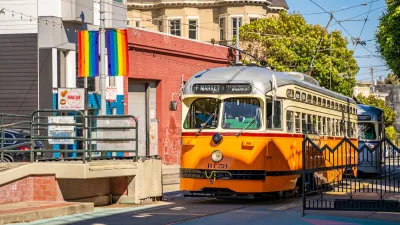The San Francisco rapid bus line is making transit on the corridor more reliable and reducing traffic crashes and congestion.

A Bus rapid transit (BRT) project in San Francisco earned the highest-level designation achieved by U.S. transit projects, Silver, by the Institute for Transportation and Development Policy (ITDP) for its effectiveness in improving transit travel times along the Van Ness corridor.
According to a press release from the city, “The Van Ness project includes dedicated center running transit lanes that don’t get slowed down by parking or turning vehicles, transit signal priority that gives buses the green light as they approach an intersection, as well as low-floor vehicles and all-door boarding, that make it quicker and easier for passengers to load and unload at each stop and fast and frequent operations.”
According to data from the SFMTA, “Bus travel on this corridor is now 36% faster, injury traffic collisions are down by 54%, and transit is 45% more reliable.” The project also added pedestrian bulbouts, countdown signals, and other infrastructure to make walking safer.
Raymone Garner, a Muni Operator of 23 years, said the BRT line “gives us a smoother ride that’s safer with better on-time performance. Riders love it because it’s easier for us to get into the bus zone so it’s easier and safer to pick up passengers, especially people with disabilities.”
The press release adds, “The other BRT Silver-designated projects in the nation include the New Britain Busway in Hartford, Connecticut and the Healthline in Cleveland, Ohio. California has two Bronze projects; the Orange (G) Line in Los Angeles and the sbX E Street Bus BRT in San Bernardino.”
FULL STORY: San Francisco's First Bus Rapid Transit Project Receives Internationally Recognized Designation

Alabama: Trump Terminates Settlements for Black Communities Harmed By Raw Sewage
Trump deemed the landmark civil rights agreement “illegal DEI and environmental justice policy.”

Planetizen Federal Action Tracker
A weekly monitor of how Trump’s orders and actions are impacting planners and planning in America.

How Atlanta Built 7,000 Housing Units in 3 Years
The city’s comprehensive, neighborhood-focused housing strategy focuses on identifying properties and land that can be repurposed for housing and encouraging development in underserved neighborhoods.

In Both Crashes and Crime, Public Transportation is Far Safer than Driving
Contrary to popular assumptions, public transportation has far lower crash and crime rates than automobile travel. For safer communities, improve and encourage transit travel.

Report: Zoning Reforms Should Complement Nashville’s Ambitious Transit Plan
Without reform, restrictive zoning codes will limit the impact of the city’s planned transit expansion and could exclude some of the residents who depend on transit the most.

Judge Orders Release of Frozen IRA, IIJA Funding
The decision is a victory for environmental groups who charged that freezing funds for critical infrastructure and disaster response programs caused “real and irreparable harm” to communities.
Urban Design for Planners 1: Software Tools
This six-course series explores essential urban design concepts using open source software and equips planners with the tools they need to participate fully in the urban design process.
Planning for Universal Design
Learn the tools for implementing Universal Design in planning regulations.
Jessamine County Fiscal Court
Caltrans
Institute for Housing and Urban Development Studies (IHS)
City of Grandview
Harvard GSD Executive Education
Toledo-Lucas County Plan Commissions
Salt Lake City
NYU Wagner Graduate School of Public Service





























